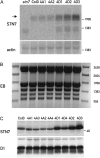The phosphorylation status of the chloroplast protein kinase STN7 of Arabidopsis affects its turnover
- PMID: 21976483
- PMCID: PMC3327173
- DOI: 10.1104/pp.111.187328
The phosphorylation status of the chloroplast protein kinase STN7 of Arabidopsis affects its turnover
Abstract
The chloroplast serine-threonine protein kinase STN7 of Arabidopsis (Arabidopsis thaliana) is required for the phosphorylation of the light-harvesting system of photosystem II and for state transitions, a process that allows the photosynthetic machinery to balance the light excitation energy between photosystem II and photosystem I and thereby to optimize the photosynthetic yield. Because the STN7 protein kinase of Arabidopsis is known to be phosphorylated at four serine-threonine residues, we have changed these residues by site-directed mutagenesis to alanine (STN7-4A) or aspartic acid (STN7-4D) to assess the role of these phosphorylation events. The corresponding mutants were still able to phosphorylate the light-harvesting system of photosystem II and to perform state transitions. Moreover, we noticed a marked decrease in the level of the STN7 kinase in the wild-type strain under prolonged state 1 conditions that no longer occurs in the STN7-4D mutant. The results suggest a possible role of phosphorylation of the STN7 kinase in regulating its turnover.
Figures





Similar articles
-
Functional redox links between lumen thiol oxidoreductase1 and serine/threonine-protein kinase STN7.Plant Physiol. 2021 Jun 11;186(2):964-976. doi: 10.1093/plphys/kiab091. Plant Physiol. 2021. PMID: 33620491 Free PMC article.
-
High light induced disassembly of photosystem II supercomplexes in Arabidopsis requires STN7-dependent phosphorylation of CP29.PLoS One. 2011;6(9):e24565. doi: 10.1371/journal.pone.0024565. Epub 2011 Sep 7. PLoS One. 2011. PMID: 21915352 Free PMC article.
-
Control of STN7 transcript abundance and transient STN7 dimerisation are involved in the regulation of STN7 activity.Planta. 2013 Feb;237(2):541-58. doi: 10.1007/s00425-012-1775-y. Epub 2012 Oct 21. Planta. 2013. PMID: 23086342
-
Dynamics of reversible protein phosphorylation in thylakoids of flowering plants: the roles of STN7, STN8 and TAP38.Biochim Biophys Acta. 2011 Aug;1807(8):887-96. doi: 10.1016/j.bbabio.2010.08.002. Epub 2010 Aug 20. Biochim Biophys Acta. 2011. PMID: 20728426 Review.
-
Protein kinases and phosphatases involved in the acclimation of the photosynthetic apparatus to a changing light environment.Philos Trans R Soc Lond B Biol Sci. 2012 Dec 19;367(1608):3466-74. doi: 10.1098/rstb.2012.0064. Philos Trans R Soc Lond B Biol Sci. 2012. PMID: 23148273 Free PMC article. Review.
Cited by
-
Redox regulation of thylakoid protein kinases and photosynthetic gene expression.Antioxid Redox Signal. 2013 Jun 1;18(16):2184-201. doi: 10.1089/ars.2012.5110. Epub 2013 Mar 15. Antioxid Redox Signal. 2013. PMID: 23339452 Free PMC article. Review.
-
STN7 is not essential for developmental acclimation of Arabidopsis to light intensity.Plant J. 2023 Jun;114(6):1458-1474. doi: 10.1111/tpj.16204. Epub 2023 Apr 11. Plant J. 2023. PMID: 36960687 Free PMC article.
-
Structure of the catalytic domain of a state transition kinase homolog from Micromonas algae.Protein Cell. 2013 Aug;4(8):607-19. doi: 10.1007/s13238-013-3034-9. Epub 2013 Jun 23. Protein Cell. 2013. PMID: 23794031 Free PMC article.
-
Changes in the Phosphoproteome and Metabolome Link Early Signaling Events to Rearrangement of Photosynthesis and Central Metabolism in Salinity and Oxidative Stress Response in Arabidopsis.Plant Physiol. 2015 Dec;169(4):3021-33. doi: 10.1104/pp.15.01486. Epub 2015 Oct 15. Plant Physiol. 2015. PMID: 26471895 Free PMC article.
-
Signal integration by chloroplast phosphorylation networks: an update.Front Plant Sci. 2012 Nov 20;3:256. doi: 10.3389/fpls.2012.00256. eCollection 2012. Front Plant Sci. 2012. PMID: 23181067 Free PMC article.
References
-
- Bellafiore S, Barneche F, Peltier G, Rochaix JD. (2005) State transitions and light adaptation require chloroplast thylakoid protein kinase STN7. Nature 433: 892–895 - PubMed
-
- Bonardi V, Pesaresi P, Becker T, Schleiff E, Wagner R, Pfannschmidt T, Jahns P, Leister D. (2005) Photosystem II core phosphorylation and photosynthetic acclimation require two different protein kinases. Nature 437: 1179–1182 - PubMed
-
- Clough SJ, Bent AF. (1998) Floral dip: a simplified method for Agrobacterium-mediated transformation of Arabidopsis thaliana. Plant J 16: 735–743 - PubMed
-
- Depège N, Bellafiore S, Rochaix JD. (2003) Role of chloroplast protein kinase Stt7 in LHCII phosphorylation and state transition in Chlamydomonas. Science 299: 1572–1575 - PubMed
-
- Huesgen PF, Schuhmann H, Adamska I. (2006) Photodamaged D1 protein is degraded in Arabidopsis mutants lacking the Deg2 protease. FEBS Lett 580: 6929–6932 - PubMed
Publication types
MeSH terms
Substances
LinkOut - more resources
Full Text Sources
Molecular Biology Databases

